Materials Handling - Lifting With Eye Bolts
On this page
How should you select the right bolt?
Back to topUse the eye bolt that is stamped with its rated weight. Some eye bolts are marked with their thread size NOT with their rated capacities. Make sure you select the correct eyebolt based on its type and capacity for the lift you are conducting.
- Use plain or regular eye bolts (non-shoulder) or ring bolts for vertical loading only. Angle loading on non-shoulder bolts will bend or break them.
- Use shoulder eye bolts for vertical or angle loading. Be aware that lifting eye bolts at an angle reduces the safe load.
- Follow the manufacturer's recommended method for angle loading.
- Use an eye bolt that is made of materials that can withstand the environment it is being used in (e.g., corrosion, extreme weather, etc.)
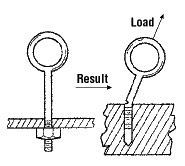
Incorrect use of shoulder bolt
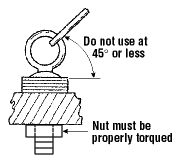
Shoulder eye bolt with load correctly applied
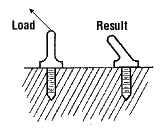
Incorrect way of applying angle load
How should you use eye bolts safely?
Back to top- Orient the eye bolt in line with the slings. If the load is applied sideways, the eye bolt may bend.
- Pack washers between the shoulder and the load surface to ensure that the eye bolt firmly contacts the surface. Make sure that the nut is properly torqued.
- Engage at least 90% of threads in a receiving hole when using shims or washers.
- Attach only one sling leg to each eye bolt.
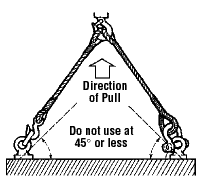
- Inspect and clean the eye bolt threads and the hole. Check for bends, cracks, or worn threads.
- Screw the eye bolt on all the way down and properly seat.
- Ensure the tapped hole for a screw eye bolt (body bolts) has a minimum depth of one-and-a-half times the bolt diameter.
- Install the shoulder at right angles to the axis of the hole. The shoulder should be in full contact with the surface of the object being lifted.
- Use a spreader bar with regular (non-shoulder) eye bolts to keep the lift angle at 90° to the horizontal.
- Use eye bolts at a horizontal angle greater than 45°. Sling strength at 45° is 71% of vertical sling capacity. Eye bolt strength at 45° horizontal angle drops down to 30% of vertical lifting capacity.
- Use a swivel hoist ring for angled lifts. The swivel hoist ring will adjust to any sling angle by rotating around the bolt and the hoisting eye pivots 180°.
What should you avoid when using eye bolts?
Back to top- Do not run a sling through a pair of eye bolts – it will reduce the effective angle of lift and will put more strain on the rigging.
- Do not force the slings through eye bolts. This force may alter the load and the angle of loading.
- Do not use eye bolts that have been ground, machined or stamped.
- Do not use bars, grips or wrenches to tighten eye bolts.
- Do not paint an eye bolt. The paint could cover up flaws.
- Do not force hooks or other fittings into the eye; they must fit freely.
- Do not shock load eye bolts.
- Do not use a single eye bolt to lift a load that is free to rotate.
- Do not use eye bolts that have worn threads or other flaws.
- Do not insert the point of a hook in an eye bolt. Use a shackle.
- Do not use a shackle that is capable of lifting more than the eye bolt – the eye bolt may become overloaded.
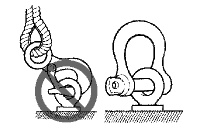
- Fact sheet last revised: 2019-04-08

